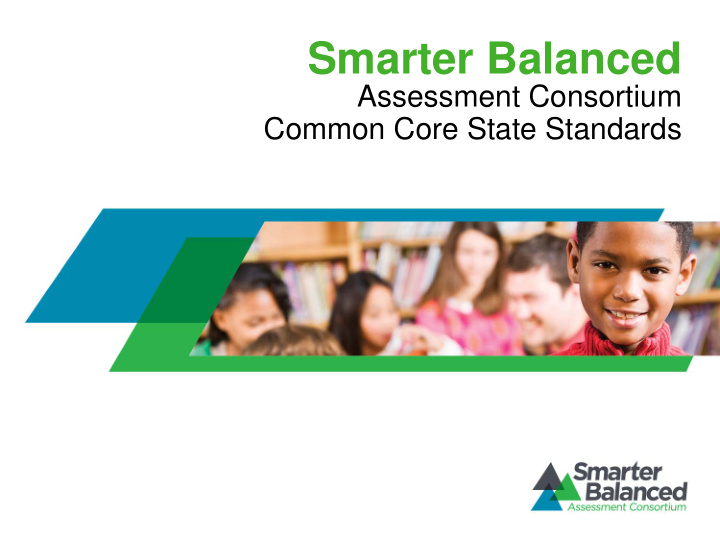



Smarter Balanced Assessment Consortium Common Core State Standards
A National Consortium of States • 25 states representing 40% of K-12 students • 21 governing, 4 advisory states • Washington state is fiscal agent
The Purpose of the Consortium • To develop a comprehensive and innovative assessment system for grades 3-8 and high school in English language arts and mathematics aligned to the Common Core State Standards, so that... • ...students leave high school prepared for postsecondary success in college or a career through increased student learning and improved teaching [The assessments shall be operational across Consortium states in the 2014-15 school year]
Next Generation Assessments The U.S. Department of Education has funded two consortia of states with development grants for new assessments aligned to the Common Core State Standards • Rigorous assessment of progress toward “ college and career readiness” • Common cut scores across all Consortium states • Provide both achievement and growth information • Valid, reliable, and fair Valid, reliable, and fair for all students, except those with “significant cognitive disabilities” • Administer online • Use multiple measures • Operational in 2014-15 school year Source: Federal Register / Vol. 75, No. 68 / Friday, April 9, 2010 pp. 18171-85
Consortium Work Groups
Smarter Balanced Group Hawaii Officials Assigned State Lead Cara Tanimura, Systems Accountability Office (SAO) Co ‐ Chair, Test Design and Validation Patricia Reiss, PhD, SAO/SAS Member, Technology Approach and Reporting Brian Reiter, SAO/SAS Teacher Involvement Coordinator Carol Anton, SAO/SAS Member, Formative Assessment Practices and Monica Mann, Office of Curriculum, Professional Learning/Transition to Common Instruction and Student Support (OCISS) Core Member, Technology Approach and Reporting Justin Katahira, Data Governance Office (DGO) David Wu, Office of Information Technology Member, Architecture Review Board Services (OITS) State Technology Assessment Readiness Mel Decasa, OITS Coordinator Higher Education Lead Linda Johnsrud, PhD, University of Hawaii at Manoa Member, Test Design and Validation Laura Lyons, PhD, University of Hawaii at Manoa
A Balanced Assessment System Summative assessments Benchmarked to college and career readiness Common Common Core State Core State Teachers and All students All students Standards Standards schools have leave leave specify specify information and high school high school K-12 K-12 tools they need college college expectations expectations to improve and career and career for college for college teaching and ready ready and career and career learning readiness readiness Teacher resources for Interim assessments formative Flexible, open, used assessment for actionable practices feedback to improve instruction
A Balanced Assessment System ELA/Literacy and Mathematics, Grades 3-8 and High School School Year Last 12 weeks of the year* DIGITAL LIBRARY of formative tools, processes and exemplars; released items and tasks; model curriculum units; educator training; professional development tools and resources; scorer training modules; and teacher collaboration tools. Summative Assessment for Accountability Optional Interim Optional Interim Assessment Assessment Performance Computer Computer Adaptive Computer Adaptive Tasks Adaptive Assessment and Assessment and Assessment Performance Tasks Performance Tasks •ELA/literacy •ELA/literacy •Mathematics •Mathematics Scope, sequence, number and timing of interim assessments locally determined Re-take option available *Time windows may be adjusted based on results from the research agenda and final implementation decisions.
Assessment System Components
Assessment System Components • Optional comprehensive and content-cluster assessment to help identify specific needs of each student • Can be administered throughout the year • Provides clear examples of expected performance on Common Core standards • Includes a variety of question types: selected response, short constructed response, extended constructed response, technology enhanced, and performance tasks • Aligned to and reported on the same scale as the summative assessments • Fully accessible for instruction and professional development
Assessment System Components “ The use of performance measures has been found to increase the intellectual challenge in classrooms and to support higher- ” quality teaching. - Linda Darling-Hammond and Frank Adamson, Stanford University
Assessment System Components “ Few initiatives are backed by evidence that they raise achievement. Formative assessment is one of the few approaches proven to ” make a difference. - Stephanie Hirsh, Learning Forward
Assessment System Components “ Data are only useful if • Static and dynamic reports, secure and public views people are able to • Individual states retain jurisdiction over access and access, understand and appearance of online reports • Dashboard gives parents, students, use them… For practitioners, and policymakers information to be useful, access to assessment information it must be timely, readily • Graphical display of learning progression status (interim available, and easy to assessment) ” • Feedback and evaluation understand. mechanism provides surveys, open feedback, and vetting of materials - Data Quality Campaign
Support for Special Populations • Accurate measures of progress for students “ with disabilities and Common- English Language Learners Core Tests • Accessibility and Accommodations Work to Have Built-in Group engaged ” Accommodations throughout development • Outreach and - June 8, 2011 collaboration with relevant associations
Exploring the Sample Items
Recommend
More recommend